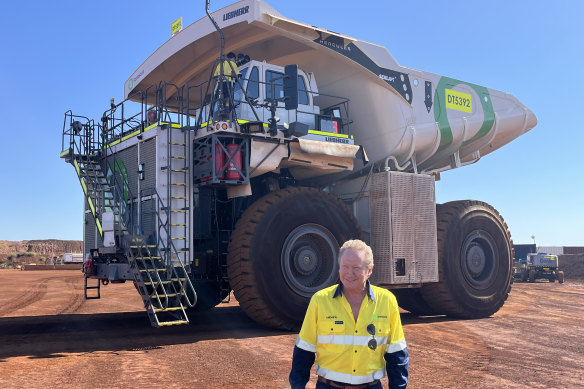By Peter Milne
Just weeks ago Fortescue shed 700 workers and dumped a target to be a major producer of green hydrogen by 2030, but the miner’s billionaire owner Andrew Forrest still insists his native Pilbara can supply the globe with green iron.
Straight from a dinner in China the night before, the company founder pointed to the red dirt at his feet at Fortescue’s Cloudbreak mine, said, “this is rich iron,” then turned his hand up to the blue sky and said, “and that is energy.”

Andrew Forrest after driving a prototype hydrogen-powered electric haul truck called Europa – named after a moon of hydrogen-filled Jupiter.Credit: Peter Milne
The simple proposition of combining ample raw material and energy occurring in the same place will succeed or fail on practicalities.
When questioned about whether he is overly ambitious, Forrest always has the justified retort that many doubted if then tiny Fortescue could break the BHP-Rio Tinto duopoly and become the third force in Pilbara iron ore mining.
Fortescue’s $53 billion market capitalisation is proof he got it right, but Forrest’s next challenge is tougher.
His first success, in iron ore, was as a late entrant into an existing business. This time he wants to be one of the first movers into a sector that hardly exists outside the laboratory.
Steelmaking produces by some counts 10 per cent of global greenhouse gas emissions. Most of it is made from iron ore – a mix of iron and oxygen – in huge integrated steel plants.
First the oxygen is removed in a process called reduction, using coal for heat and to aid the chemical reaction. The result is iron, and an enormous amount of carbon pollution. Next the iron is refined and turned into steel.
Forrest wants the first, most polluting part of the process, to be done in the Pilbara and to ship the zero-emissions green iron to the world.
On Friday he turned the first sod on what in 12 months’ time is to be a $75 million electric smelting furnace to test different ways of producing 1500 tonnes of green iron a year.
Right now it is a flattened piece of dirt, but Fortescue was keen to show progress elsewhere. Zero-emissions iron needs zero-emissions iron ore, and Fortescue is aiming for its mining to be fossil-fuel free by 2030.
That will require more than two gigawatts of solar and wind generation and massive battery storage to provide reliable power – enough for about a million homes, the company said.
Fortescue said the plant, an electric smelting furnace, would use green hydrogen produced by the company.
The project milestone follows Fortescue’s announcement last month that it would cut 700 jobs and merge its mining and energy divisions, as it also tempered its ambition to be a major producer of the clean fuel hydrogen.
Forrest has maintained he is committed to green hydrogen, and on Friday, West Australian Premier Roger Cook said hydrogen had an important role to play in remote areas such as mine sites.
“WA is on its way to becoming a global clean energy powerhouse, and a major producer, user and exporter of green iron,” Cook said.
The Business Briefing newsletter delivers major stories, exclusive coverage and expert opinion. Sign up to get it every weekday morning.